On Feb. 18, the Alaska House of Representatives organized under the control of a multipartisan coalition caucus, voting 22-17 to approve a plan of organization placing members of the coalition in charge of committees. Since the start of the legislative session on Jan. 19, the House was split evenly between a Republican bloc and a coalition of Democrats, independents, and Louise Stutes (R). The group was joined by Reps. Sara Rasmussen (R) and Kelly Merrick (R) in the vote on organizing the House (another legislator, Rep. Mike Prax (R), was not present for the vote). Though the coalition caucus received enough votes to organize the chamber, two of the legislators who voted alongside the coalition to assign committee membership —Reps. Sara Rasmussen (R) and Geran Tarr (D)—said they would not join either the coalition or Republican caucuses, leaving both groups without a numerical majority in the 40-member House.
Rasmussen said she would serve as an independent Republican not affiliated with the coalition majority or the Republican minority. With Stutes and Kelly Merrick (R) already a part of the coalition caucus, Rasmussen’s decision left the Republican caucus with 18 members. Tarr (D) also said she would vote independent of the caucus, leaving it with 20 members—14 Democrats, four independents, and two Republicans. Though both Rasmussen and Tarr voted with the coalition caucus to approve committee assignments, neither has stated whether they will continue to support the coalition in future votes. “We’re still working on things here,” Tarr said. Rasmussen said that although she hasn’t “made an agreement to vote on anything,” she hopes that “with compromise, there will be some good policy that can move forward.”
Under the approved organization plan, Rep. Chris Tuck (D) will serve as majority leader and Rep. Cathy Tilton (R) will serve as minority leader. Reps. Neal Foster (D) and Kelly Merrick (R) will co-chair the House Finance Committee and Rep. Bryce Edgmon (I) will lead the Rules Committee, which determines whether bills receive a floor vote. Out of the other eight standing committees in the House, six will be chaired or co-chaired by Democrats, one will be chaired by an independent, and one will be co-chaired by a Democrat and an independent.
The situation in the Alaska House is unusual; generally, the party with a numerical majority organizes to select presiding officers, appoint committee members, and vote on legislation. A coalition caucus was formed in the House after the 2018 elections despite Republicans winning a majority of the seats in the chamber, but that coalition was composed of 25 members, four more than the 21 votes needed to assign committee membership and pass legislation. Republicans maintained a numerical majority of 21 members after the 2020 elections, but Stutes’ decision to join the coalition group left each faction with 20 members. Merrick later joined the coalition bloc as well, but Tarr’s decision to vote separately from the coalition kept it from reaching 21 members.
Jennifer Fletcher, a state legislative librarian, said she did not know of any previous case where a 20-member caucus negotiated with other legislators to acquire the votes necessary to control the chamber. Forrest Nabors, chair of the political science department at the University of Alaska Anchorage, said that the situation in the House was “highly unusual,” but that, in Alaska, “party affiliations are not the same as they are in other states and in the country in general. Hence, I think we err in trying to frame majorities and minorities in our state in terms of parties. For the last three legislative sessions, that mold has been formally broken, and our nomenclature should recognize that break.”
Out of the 99 legislative chambers in the country, the Alaska House is the only chamber under the control of a multipartisan, power-sharing coalition after the 2020 elections, with Republicans controlling 61 legislative chambers and Democrats controlling 37. Alaska is one of 12 states under divided government as opposed to a state government trifecta in which one party holds the governorship, a majority in the state senate, and a majority in the state house. There are currently 15 Democratic and 23 Republican trifectas.
Additional reading:


